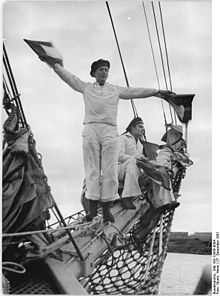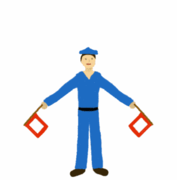Wink alphabet
The winker alphabet (semaphore) is used for the optical transmission of messages between ships or on land. With the development of radiotelephony , it lost much of its importance, but is still used primarily for military purposes at sea, because - in contrast to almost all radio communications - it is difficult to intercept . It is still an official means of communication with the United States Navy and the Japanese Sea Self-Defense Forces , but is also used by other navies.
There is an international (defined in the International Signal Book ) and a German winker alphabet.
The individual letters of the Latin alphabet are described in the winker alphabet by the position in which the winker holds two flags. The flags are mostly square and either yellow-red divided diagonally (Oscar flag) or red flags containing a smaller, centered white square (obsolete).
While individual letters are transmitted with the winker alphabet, the flag alphabet is used to transmit coded messages by using less colored flags.
International wink alphabet
The figures show the signals in the international winker alphabet as the receiver sees them.
In the gray cells, the flags would overlap according to the system. Yellow cells indicate the actual ergonomic hand position.
| right arm → | 0 ° | 45 ° | 90 ° | 135 ° | 180 ° | 225 ° | 270 ° | 315 ° |
| left arm ↓ | ||||||||
| 0 ° |
 Interruption Interruption
|
A. | B. | C. | D. | E. | F. | G |
| 45 ° |
 A. |
H | I. | K | L. | M. | N | |
| 90 ° |
 B. |
 H |
O | P | Q | R. | S. | |
| 135 ° |
 C. |
 I. |
 O |
T | U | Y | ||
| 180 ° |
 D. |
 K |
 P |
 T |
Numbers follow | Letters follow / J | V | |
| 225 ° |
 E. |
 L. |
 Q |
 U |
 Numbers follow |
W. | X | |
| 270 ° |
 F. |
 M. |
 R. |
 Y |
 Letters follow / J |
 W. |
Z | |
| 315 ° |
 G |
 N |
 S. |
 V |
 X |
 Z |
Numbers are announced by the "number following" signal and correspond to the first ten letters of the alphabet, Alfa (= 1) to Kilo (= 0) without Juliett. The number ends with the next "interruption" signal. The signals "Charlie" and "Echo" also serve as reply and error signals.
In addition to the well-known winker alphabet, there were various forerunners, including the Wig-Wag developed by Albert J. Myer (also: Meyer) in the American Civil War in 1860 with only one signal flag. The system distinguished 4 flag positions: Done, 1, 2 and 3. A combination of these positions was assigned to the letters of the alphabet and numbers 1 to 0, which was based on the frequency in the English language.
Influence and advancement
Campaign for Nuclear Disarmament
One of the most famous symbols of everyday life, which can be derived from the flag semaphore is Gerald Holtoms Peace Sign : This originally stood for Campaign for N uclear D isarmament (Campaign for Nuclear Disarmament), symbolized by the letter "N" and "D" .
Identitarian movement
In addition to the iconography of the comic film adaptation 300 , the symbol of the Identitarian Movement can also be read as a semaphore N and thus corresponds to the common use of the letter N in right-wing circles as a (hidden) identifier for nationally -minded “comrades”. Compare with this the popularity of the shoe brand New Balance in these circles, which countered their appropriation through targeted advertising with black and “foreign” looking models in advertising.



